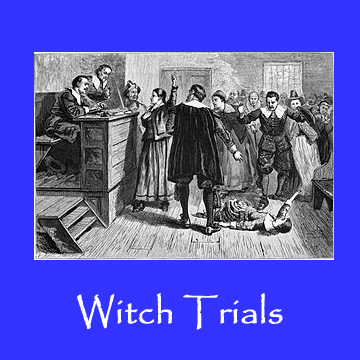After Goody Knapp’s conviction, she was visited in jail by other women of the town, and many of the appeals they made to her to rescind are striking. A Goody Pell remarked that “before she was condemned, she might think a confession a means of taking away her life, but now she must die and therefore must discover (expose) all.” Another woman advised her to “do as the witch in the other town had done, that is, to discover all she knew to be witches.” And one Elizabeth Brewster told Goody Knapp “if you keep it a little longer till you come up to the ladder, the devil will have you quick if you reveal it not until then.” Knapp replied “take heed the devil have not you, for she could not tell how soon she might be her companion.”
As was the case with most women accused of witchcraft, a great amount of pressure was put upon them both during their trial and after their conviction to accuse other townspeople of the same offense. Frequently, the psychological strain endured by the condemned was enough to manifest itself in delusions or mental breakdowns that seemed self-incriminating by nature.
One of the chief designs of Goody Knapp’s fellow townspeople was to extract from her an accusation against Goody Staples, who had been long suspected of evil doings. Goody Knapp, however, would never speak against Goody Staples, saying only that “the truth is that you would have me say that Goody Staples was a witch… I know nothing of Goodwife Staples, and I hope she was an honest woman.” And Goodwife Staples, for her part, never spoke against Goody Knapp, saying during the latter’s trial “why should she [Knapp] confess that which she was not… and if Knapp were one she would confess it.”
During one session of questioning and visitation after her conviction, the strain bearing upon Goody Knapp was beginning to show. To one interrogator she replied, “hold your tongue, you know not what I know, I have ground for what I say, I have been fished withal in private more than you are aware of….” Discussion continued in this vein, and the position of Goody Knapp became more and more uncomfortable. She reportedly declared “that a woman in the town was a witch and would be hanged within a twelvemonth.” In an increasingly agitated state, she made tantalizing references to “Indian gods” and “shining things which shine lighter than the day.” And when a friend “told her she was now to die, and therefore she should deal truly, she burst forth into weeping and desired [the visitor] to pray for her, and said she knew not how she was tempted: ‘never a poor creature was tempted as I am tempted; pray, pray for me.'”
Like all such events, the hanging of Goody Knapp attracted a large crowd of onlookers. No sooner had she been pronounced dead and “cut down” from the gallows than a large group of women pressed forward “looking for the marks of a witch upon the body.” They proceeded to “tumble the corpse up and down;” then “several… said they could find none” and a heated discussion ensued. Goodwife Staples seemed particularly upset: “wringing her hands and taking the Lord’s name in her mouth… she said ‘will you say these are witch’s teats? They are not.'”
Witnesses would later remember that she “handled the said teats very much” and “pulled them with her fingers as though she would have pulled them off.” Presently, Goody Staples called upon Goody Lockwood to come and reiterated her protest: “if these be teats, here are no more teats than I myself have, or any other woman, or you either if you would search your body.” Goody Lockwood answered tartly: “I know not what you have, but for myself, if any find such things about me, I deserve to be hanged as she was.” There was still more “handling” of the corpse, and more argument. Goody Staples persisted in her objections, although “several of the women cried her down and said they were teats.”
At length, the group was joined by a certain Goodwife Odell, who had “searched” the convict prior to her execution with a court-appointed committee. Goody Odell “showed them the marks that were upon her [Knapp] and asked what are these and they all wondered, and Goodwife Staples in particular, and said they never saw such things in their life before.”
Goody Knapp was one of eight women to be tried for witchcraft in Connecticut prior to 1660; seven of these, including Knapp, were executed. This was followed by the “Hartford Outbreak” of 1662-5, considered New England’s largest 17th century witch hunt. 17 persons were tried, and of those, 4 were executed. Another event took place in 1692, concurrent with the early months of the infamous witch hunt in Salem, Massachusetts. Known as the “Fairfield Outbreak,” this event produced only a handful of accusations, two of which went to trial, and both of the suspects were acquitted. The “Fairfield Outbreak” marked the beginning of the end for accusations of witchcraft in New England.



